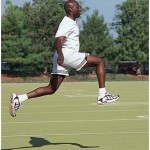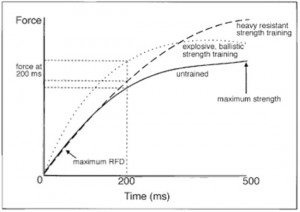 Last week, someone asked, “If you only had ONE movement/exercise to train for lower extremity power, what would it be?”
Last week, someone asked, “If you only had ONE movement/exercise to train for lower extremity power, what would it be?”
My answer: “Without context . . . it is pretty difficult to answer. Power for a runner? Football lineman? Soccer forward? Goalkeeper? Olympic lifter? Sorry to be hung up on semantics, but it does matter in this case.”
Others suggested:
- squat (and variations)
- deadlift followed by box jumps
- deadlift and swinging kettlebell turns
- deadlift
- Olympic lifts
Take a look to the right at a video of Gerald Green dunking. Look especially at the :14 mark. Getting above the rim takes more than deadlifting and kettlebells. So, aside from God-given talent and ability, how did Mr. Green almost hit his head on the rim?
There are a variety of training approaches to help Mr. Green (and others) improve their explosiveness. Before discussing those modes, a few definitions:
- Speed-strength
- force developed rapidly or at high velocities (Plisk, Potach)
- Rate of force development (RFD)
- the ability to quickly achieve maximal force at the beginning of a muscle action (Siff)
- Maximum strength
- the force a muscle or muscle group can exert in one maximal effort, and it can be quantified by the maximum weight that can be lifted once (Earle)
- Strength-endurance
- the ability to maintain muscle activity for long durations (Siff, Plisk)
- Stretch shortening cycle (SSC)
- employs the energy storage capabilities of the body’s natural elasticity and stimulation of the stretch reflex to facilitate a maximal increase in muscle recruitment over a minimal amount of time (Potach)
- Impulse
- the effect of a force applied over time (Newton, basically)
Each of the above definitions, with the exception of maximum strength, ignores traditional strength and power training teachings (i.e., the way I was taught in school). I would suggest the “best” way to look at power is by evaluating the relationship of force and time. Take a look at the image below, time on the x axis, force on the y axis. The faster an athlete is able to develop force, the higher his/her RFD. The greater an athlete’s RFD, the better able he/she is to: get out of the blocks more quickly, explode off the line of scrimmage, jump to clear a high shot in soccer, or emulate Mr. Green’s above dunk. So, striving to improve RFD should be considered paramount if the goal of training is to improve explosiveness/power.

So, now getting to the answer to the original question asked, how best to train lower extremity power? While the below list is NOT all inclusive, it includes the primary methods available to us. Each mode is followed with a quick intro.
- Sprinting
- speed-strength is the application of max force at high velocities
- this is the basis of speed training
- improving speed-strength is done by performing rapid movements with and without resistance, e.g., sprinting
- Strength Training
- Most sport movements involve faster movements and higher power outputs than what are produced during a 1RM test
- This does not mean that an athlete’s power capabilities are unaffected by maximal muscular strength training, however.
- Because speed- or power-related sport movements often begin from zero or near-zero velocities, slow-velocity strength gains have direct application to power production
- More information available in Earle & Baechle’s Essentials of Strength Training & Conditioning regarding proper loading of traditional strength training exercises to improve power production
- Weightlifting (not strength training, there’s a difference)
- A sport requiring significant power and reliance on the SSC
- Involves lifting a barbell overhead
- Rationale
- Uses Stretch Shortening Cycle
- Requires Explosive Movements
- Sport-Specific Movement Patterns
- Lifts
- Clean and Jerk
- lifting barbell from the floor to the shoulders in one continuous motion
- then, using a second motion, bringing the weight to arm’s length overhead
- Snatch
- lifting barbell from the floor to arm’s length overhead in one continuous motion
- Variations
- Power snatch, power clean, hang clean, push press
- Plyometrics
- Rationale
- Uses Stretch Shortening Cycle
- Training Adaptations (among others)
- Increased power production (as measured by vertical jump height)
- Stretch Reflex
- Decreased Latency?
- Decreased EMD?
- Increased Amplitude?
So what’s the answer to the question, “If you only had ONE movement/exercise to train for lower extremity power, what would it be?”
I will stick with my original answer, it depends.
- Plyometrics for gymnasts, sprinters, long distance runners, basketball players, soccer players (among others)
- Weightlifting for football players, basketball players
- Strength training for football players, basketball players, soccer players
- Some form of sprinting for nearly all (including long distance runners)
